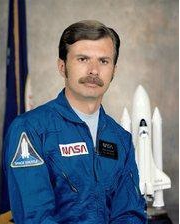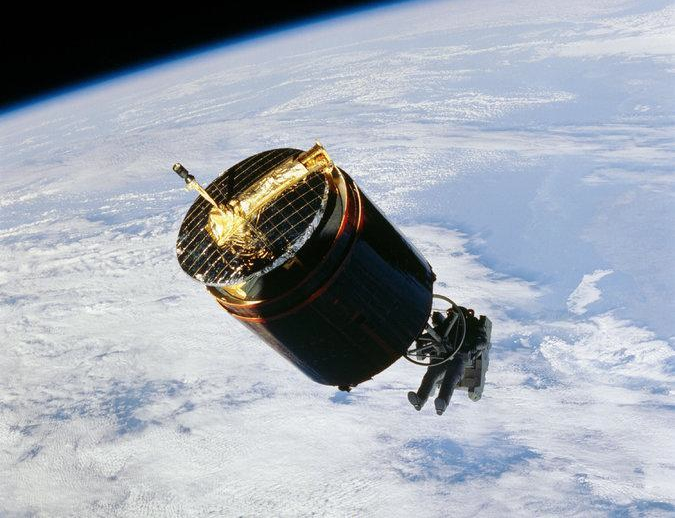[SatNews] “So now, appearing a bit more like Laurel and Hardy moving a piano, the two astronauts on their own struggled to push and turn and steady the nine-foot-long satellite."
Dale A. Gardner, an astronaut who helped lead the first salvage operation in space, steering a jet-propelled backpack to corral two wayward satellites and bring them aboard the space shuttle Discovery, all while orbiting 224 miles above Earth, died February 19 in Colorado Springs, Colorado. He was 65.
His death was confirmed by NASA, which did not provide a cause.
During the course of two spacewalks from Novemberk 12-14, 1984, Mr. Gardner and a colleague, Joseph P. Allen, each used a nitrogen-gas-powered manned maneuvering unit, or MMU, to travel the 35 feet from the shuttle to the stranded satellites. Both satellites, the Palapa B-2 and the Westar 6, which had been deployed from a shuttle earlier in the year, had slipped into useless orbits. Each time, the astronauts had to improvise.

The astronaut spent 337 hours in space and made 225 orbits of the Earth.
On the first walk, Allen successfully connected the Palapa to the shuttle’s mechanical arm. But once it was brought close to the shuttle, an obstruction on the satellite prevented the mechanical arm from positioning it in the cargo bay.
Correspondent John Noble Wilford covered the moment for the New York Times from NASA’s mission control center in Houston. On November 13, in the lead article on the front page, he wrote:
“So now, appearing a bit more like Laurel and Hardy moving a piano, the two astronauts on their own struggled to push and turn and steady the nine-foot-long satellite.
“For 90 minutes, an entire turn around the world, Allen stretched himself to hold one end of the satellite steady, while Mr. Gardner attached clamps to the other end so that Palapa could be locked into a cradle in the cargo bay.
“‘Joe, I assume you’re comfortable there,’ Commander Gardner said to the outstretched Dr. Allen, who at 130 pounds is the smallest man in the astronaut corps, as he held onto the 1,200-pound satellite.
“‘Not very,’ Dr. Allen replied, but he held on. His booted feet were firmly planted in foot restraints on the side of the cargo bay.”
Although the weightlessness of space made the Palapa easy to move, inertia had made it hard to stop. At one point, Mr. Gardner had to jump in quickly to keep it from colliding with the shuttle. They eventually secured it in the Discovery’s cargo bay, guided by another astronaut, Anna L. Fisher, who was operating the mechanical arm from inside the shuttle.
The Westar was next. With the southeastern United States and the Caribbean below, Mr. Gardner made the 35-foot walk to the 1,000-pound satellite and connected it to the mechanical arm. But again the astronauts had to do more manual work than planned.
“Move it very gently,” the Times reported Mr. Gardner saying as they eased the satellite into the remaining space in the cargo hold.

Dale Gardner used a nitrogen-gas-powered maneuvering unit to travel to the Westar 6 satellite in November 1984. NASA photo
“Believe me, brother, there’s no other way to move it,” Allen responded. Retrieving the satellites was intended to demonstrate the shuttle’s versatility as well as reduce losses by insurance companies when the two satellites were misfired into orbit. Each satellite cost $35 million. After the Westar was safely aboard, Mr. Gardner posed in space for what became a famous image, holding up a “For Sale” sign in front of the two satellites with Allen, who was taking the picture, reflected in his visor.
Dale Allan Gardner was born November 8, 1948, in Fairmont, Minnesota, and moved to Savanna, Illinois. He graduated from Savanna Community High School in 1966, the valedictorian of his class.
After receiving his bachelor’s degree in engineering physics from the University of Illinois at Urbana-Champaign, he joined the Navy to learn to fly. He excelled in flight school and was working as a Navy test pilot when NASA selected him as an astronaut candidate in 1978.
He leaves his wife, Sherry; a daughter, Lisa Gardner Hoefler; a stepdaughter, Erika Church; a stepson, Christopher Church; two grandchildren; his mother, Alice Gardner; and two sisters, Peggy Janka and Kay Zipse.
Mr. Gardner spent a total of 337 hours in space and made 225 orbits of the Earth on his two flights. He flew his first shuttle mission in 1983, on the Challenger, practicing moving heavy objects with the mechanical arm. The Challenger landed at Edwards Air Force Base in California on September 5, at 12:40 a.m., its first night landing.
After his 1984 flight on the Discovery, he expected to return to space again in 1986, in what would have been the first shuttle flight out of Vandenberg Air Force Base in California. But plans to use Vandenberg for launches were set aside after seven astronauts died when the Challenger broke apart shortly after liftoff January 28, 1986.
Mr. Gardner chose to return to active duty in the Navy that fall, and he went on to serve as deputy director for space control for the Air Force Space Command at Peterson Air Force Base in Colorado Springs. He later worked in the private sector, including for Northrop Grumman and the National Renewable Energy Laboratory in Golden, Colorado.
By William Yardley | NEW YORK TIMES

